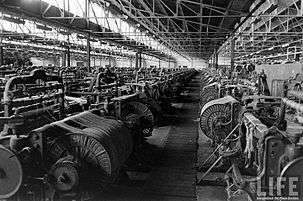Adamjee Jute Mills
 Adamjee Jute Mills entrance (1950) | |
| Public | |
| Industry | Jute |
| Founded | 1951 |
| Founder | Abdul Wahid Adamjee |
| Headquarters | Narayanganj, Bangladesh |
| Products | Jute related products |
Adamjee Jute Mill was established in Narayanganj, Bangladesh, in 1951, by Adamjee Group, immediately after Bawa Jute Mills (the first jute mill in Bangladesh). Gradually, the mill became the largest jute mill in the world preceding the jute mills of Kolkata, India, and Dundee, Scotland.[1]
History

Adamjee Jute Mills was set up by Abdul Wahid Adamjee, Pakistan's foremost industrialist, and scion of the wealthiest family in the country. Initially, the said project was a partnership between the Adamjees and the PICIC (the government’s industrial arm). The Adamjee family, however, soon took control of the project, and eventually built it into the largest jute mill in the world. At the time of partition of Bengal in 1947, there were 108 jute mills in Bengal but all of them fell to the share of India. The government of Pakistan encouraged Muslim entrepreneurs to come forward with proposals for establishment of jute mills in the country, following which Adamjee Brothers of calcutta agreed to act as a promoter and presented an investment plan in December 1949. In line with its proposal, Adamjee Brothers contributed 50% of the share capital while the Pakistan Industrial Development Corporation (PIDC) sanctioned the rest of the capital. The proposed site for the new mill was Siddhirganj, about six kilometres north of Narayanganj, which had good river, road and rail communication facilities. Two hundred twenty seven acres of land was acquired and developed for the construction of the mill. PIDC arranged for import of machinery and equipment for the mill with government grants of foreign exchange and by June 1955, the mill was ready for commissioning and had 3000 looms and 31200 spindles. The production capacity of the mill was 117 ton of twist and yarn, 953 ton of hessian and 4006 ton of sacking bag.[1] The Adamjee family lost control of the mill in 1971 during the Bangladesh Liberation War. It employed over 26,000 workers at its height.
Feature
Adamjee Jute Mills was established to utilize the relatively finer jute fibers of the Bangladesh (East Pakistan of that time) region. Narayanganj was the largest or second largest jute market of the world. As there are many rivers and was a gateway to Dhaka, Narayanganj's economic activities were largely contributed by Adamjee Jute Mills and it was also called the Dundee of the East.
In the early 1970s, polypropylene products began to displace traditional jute products, and the fall of Adamjee Jute Mills began. However, it has managed to survive 1980s with nominal margin. The death of Adamjee Jute Mills started during the 1990s.
Business
In 1999-2000, the mill had 1,939 looms for hessian, 1,103 for sacking and 234 for carpet backing cloth (CBC). The looms in operation were 1085 for hessian, 726 for sacking, and 172 for CBC. Budgeted weaving production was 19,002 ton of hessian, 34,609 ton of sacking and 6,004 ton of CBC for the year. Actual production, on the other hand, was 10,284 ton of hessian, 21,236 ton of sacking, and 3,254 ton of CBC. The mill had 515 officers, 1,561 support staff and 16,443 workers. Man-days per ton estimated for 1999-2000 were 218 for hessian, 94 for sacking and 131 for CBC, which were 189, 88 and 112 respectively in 1995-1996. The Adamjee Jute Mill has more manpower than it actually requires for production of hessian, sacking and CBC. Also, the man-days required to produce these items have also increased in the last five years. The mill has, however, achieved some improvements in terms of use of raw materials. In 1995-1996, the raw jute required to produce a ton of hessian per ton was 1,672 kg, a ton of sacking 1,494 kg and a ton of CBC 1,813 kg. The comparative figures for 1999-2000 were 1,281 kg for hessian, 1,104 kg for sacking, and 1,447 kg for CBC. A rise in the wage cost per ton from Tk 23,092, 15,780 and 22,248 for hessian, sacking and CBC respectively in 1995-1996 to Tk 27,248, Tk 18,596 and Tk 25,800 respectively in 1999-2000 has, however, offset the economy achieved in use of raw materials.
Present
After a strong battle for survival, Adamjee Jute Mills was officially closed down in 2002 despite huge protests from local policy makers and political opponents. In that place, a new industrial zone has been installed. In August 2011, the jute and textiles ministry sent a proposal to the prime minister of Bangladesh seeking her approval for rebuilding the second unit of the Adamjee Jute Mills in Narayanganj on 11 acres of land at an estimated cost of Tk 608.72 crore.[2]
See also
External links
- Adamjee EPZ eyes $400m investment in 18 months
- Tears as jute mill shuts with 30,000 job losses
- World's largest jute mill goes silent
References
- 1 2 Habibullah, M (2012). "Adamjee Jute Mill". In Islam, Sirajul; Jamal, Ahmed A. Banglapedia: National Encyclopedia of Bangladesh (Second ed.). Asiatic Society of Bangladesh.
- ↑ "Proposal to reopen AJM awaits PM's approval". Retrieved 17 October 2013.